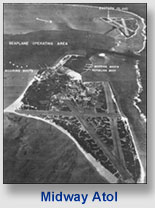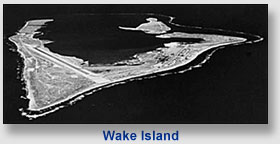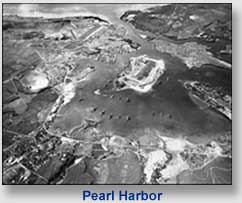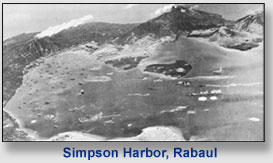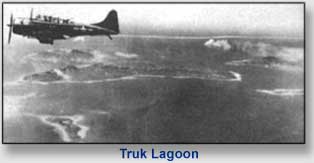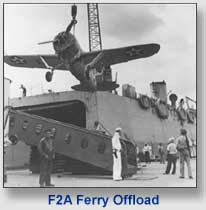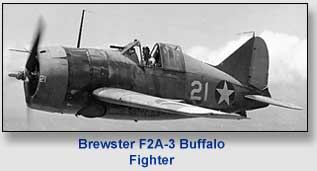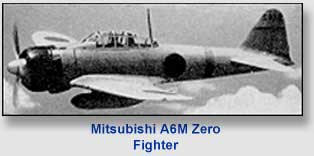 |
|||||||||||
|
|||||||||||
|
|
|||||||||||
Wake Island Defeated, Battle of Midway Pending |
|||||||||||
| The unforeseen, sixteen-day defense
by the marines of Wake
Island against the Japanese upset Admiral
Isoroku Yamamoto's plan. The doomed defenders delayed, by six
months, the offensive to capture his primary objective, Midway
Atol, one thousand miles to the northeast. The westernmost and
the oldest of the Hawaiian Island archipelago, the capture of Midway
by the Imperial Japanese Navy would cut by half the distance to
the U.S.’s now scorched fortress, Pearl
Harbor, checking America’s power in the North Pacific.
The South West Pacific was already under Japanese control from fortresses
Rabaul,
New Guinea and
Truk (now Chuuk), Micronesia. |
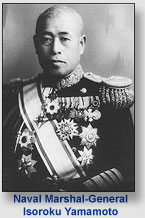 |
||||||||||
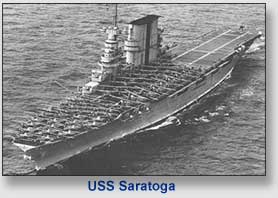 |
On Christmas day, 1941, The USS
Saratoga arrived at Midway and off loaded 14 obsolete F2A-3
Brewster “Buffalos” of MAG-21’s (Marine Air
Group-21) VMF-221 (Marine Fighter squadron)-221. No match for the
world-class Japanese fighter, the Mitsubishi
A6M “Zero,” the F2As (1) were, however, piloted
by experienced marine pilots originally sent to reinforce Wake but
were diverted to Midway when that rescue was deemed to be futile.
Fortunately, by the time of the great battle, six months later,
there were seven F4F-3s on the island that helped to improve the
odds in favor of defending Midway. |
||||||||||
|
|||||||||||
|
|
|||||||||||
| From Defense to Offense- Marine Corps Aviation Mussels Up for the Big Fight | |||||||||||
Since late in 1939, Marine Corps aviation was expanding rapidly; from 232 then to 641 pilots and from 9 squadrons to 13 as of late 1941. By the end of WWII there would be 10,049 marine aviators serving in 128 squadrons.(2) The method of the marines’ rapid expansion was usually to split an operational squadron into two squadrons so as to always have a nucleus of experienced naval aviators who would give advanced training to the new pilots fresh from flight school. So, on March 1st 1942 on Midway, a newly designated MAG-22
was begat from MAG-21
and with a cadre of VMF-221
personnel becoming the first VMF-222 pilots, ground officers, and
enlisted ground crews (something like Minerva being born whole out
of the head of Zeus). In reality, VMF-222 was only one of four “paper”
squadrons, two fighter and two dive-bomber (VMSB-241
and VMSB-244). In early April 1942, VMF-222 was reassigned to
MCAS (Marine Corps Air Station) Ewa, some nine miles west of
Pearl Harbor for further training. |
|||||||||||
MAG-22’s pilots distinguished themselves in the battle but at the loss of 24 intrepid pilots, two of whom were the commanding officers and many of the rest, senior captains. The main cause of VMF-221’s causalities was their underpowered F2A-3 that served more as a nuisance to the “state-of-the-art” Japanese Zeros that attacked the island while the bombers were attacking the Japanese fleets offshore. The few F4F “Wildcats” that went up against the Zeros could hold their own but some other US Navy fighter would have to come to the rescue to earn the air superiority over the Imperial Japanese Naval Air Service to beat back the Japanese in the Southwest Pacific. There was such a promising fighter plane in the pipeline but it was failing its carrier qualifications- the F4U-1 Chance-Vought Corporation’s “Corsair,” and the Navy’s “Brass” was about to reject it and accept the Grumman Aircraft Corporation’s F4F-1 “Hellcat” instead. |
|||||||||||
